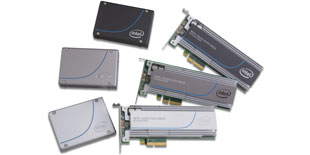Intel Solid-State Drive Data Center Family for PCIe Announced
Intel Solid-State Drive Data Center Family for PCIe Provides Breakthrough Performance to Modernize Data Center Storage
New Solid-State Drives Deliver Extraordinary Throughput, Lower Latency and Reduced Total Cost of Ownership to Meet Rigorous Performance Demands of Data Centers

June 3, 2014 Intel announced a line of powerful solid-state drives (SSDs) utilizing PCI Express (PCIe)* with NVM Express (NVMe)* technology for substantial performance gains over SATA SSDs and traditional hard disk drives (HDDs). The Intel Solid-State Drive Data Center Family for PCIe meets the increasing needs for high-performance, consistent and reliable storage solutions in the data center while helping to lower total cost of ownership. The new Intel SSD Data Center Family for PCIe includes: Intel SSD DC P3700 Series for write-intensive applications, Intel SSD DC P3600 Series for mixed workloads and Intel SSD DC P3500 Series for read-heavy uses.
Growing Storage Needs: The growing demand for information and services, especially by mobile Internet users, is driving an explosion in data, expanding databases, and massive computational and storage needs. The new Intel SSD Data Center Family for PCIe was designed to respond to these needs with high performance that improves processor utilization and scales to address performance and capacity needs. Higher throughput and reduced latency mean faster access to data and improved storage utilization of drives, lowering total cost of ownership.
Overcoming Storage Bottlenecks: The Intel SSD Data Center Family for PCIe uses the PCIe 3.0 specification and a new high-performance PCIe interface controller architected with NVMe. This technology unleashes consistent performance to overcome the toughest storage bottlenecks in the data center. NVMe technology was designed with PCIe-based SSDs in mind, eliminating much of the latency caused by legacy HDD interfaces.
Eliminating Latencies: PCIe with NVMe moves data and storage closer to the processor, eliminating significant hardware and storage protocol-related latencies and boosting the overall performance of a system, especially with intensive tasks such as virtualization, big data applications and high-performance computing. Consistent performance enables storage response in a more predictable and scalable manner, maximizing system usage and overall performance.
NVMe 1.0 Industry Standard: The NVMe 1.0 specification, a new industry-standard storage interface protocol developed by the NVMHCI Work Group*, defines a scalable architecture that unlocks the potential of PCIe interface SSDs. The standard was developed specifically for PCIe-interface SSDs and provides a substantial performance boost and reduction in latency. With a throughput improvement of up to 6x and reduced interface latency that can exceed 6 Gbps SATA SSDs, the Intel SSD Data Center Family for PCIe increases processor utilization while scaling capacity and performance to meet demand.
Better Utilization of Compute Power: The Intel SSD Data Center Family for PCIe delivers data to the processor faster and with lower latency than SATA interfaces. PCIe with NVMe technology enables the processor to avoid waiting for data, allowing for better utilization of compute power through more consistently high throughput. Increased data throughput and reduced latencies mean faster access to data, better scalability, using fewer drives to deliver the same data throughput, and helping to lower total cost of ownership.
Data Throughput Improvements: The Intel SSD Data Center Family for PCIe takes advantage of Intels third-generation controller and custom firmware, enabling data throughput improvements over traditional HDDs and other SSDs. Through NVMe-based PCIe, the new Intel SSD Data Center Family for PCIe delivers up to 2.8GB per second read speeds, up to 1.9GB per second write speeds1, and up to 460,000 input and outputs per second (IOPS). The combination provides exceptional performance for random and mixed IT workloads.
Compatibility: The Intel SSD Data Center Family for PCIe works with the NVMe drivers provided across operating systems including Windows* and Linux* and with the latest Intel platforms, including the forthcoming server platform code-named Grantley.
Protection: With multiple check points, the Intel SSD Data Center Family for PCIe protects important data, delivering stress-free data storage. Power loss protection enables data in-flight to be saved in the event of a power loss. The drives also include integrated die parity protection (XOR).
Reliability: The drives are backed by Intels 5-year limited warranty and have an average time between failures of 2 million hours, or more than 228 years. The P3700 Series offers 10 full-drive writes per day over the life of the drive2, totaling 36 petabytes, or 459 years of high-definition video. For less demanding sequential workloads, the P3600 Series delivers three drive writes per day, and the P3500 Series offers 0.3 drive writes per day. Each drive comes with an endurance manager for added reliability.
Form Factors: The Intel SSD Data Center Family for PCIe will come in a small 2.5-inch form factor (SFF-8639) for hot-swappable front panel serviceability and an add-in card form factor for broad compatibility with existing PCIe-based systems.
Capacities and Pricing: The Intel SSD Data Center Family for PCIe will be offered in 400GB, 800GB, 1.2TB (P3500 and P3600 only), 1.6TB and 2TB. Available through Intel distributors and resellers, the Intel SSD Data Center Family for PCIe is offered at a starting MSRP of $560.
For More Information: Visit www.intel.com/ssd or access the multimedia press kit at www.intel.com/newsroom/ssd. Follow Intel SSDs on Twitter, @intelssd, and on communities.intel.com.
[1] With the SSD DC P3700 Series
2 Based on JESD-219 workload
Software and workloads used in performance tests may have been optimized for performance only on Intel microprocessors. Performance tests, such as SYSmark and MobileMark, are measured using specific computer systems, components, software, operations and functions. Any change to any of those factors may cause the results to vary. You should consult other information and performance tests to assist you in fully evaluating your contemplated purchases, including the performance of that product when combined with other products.
